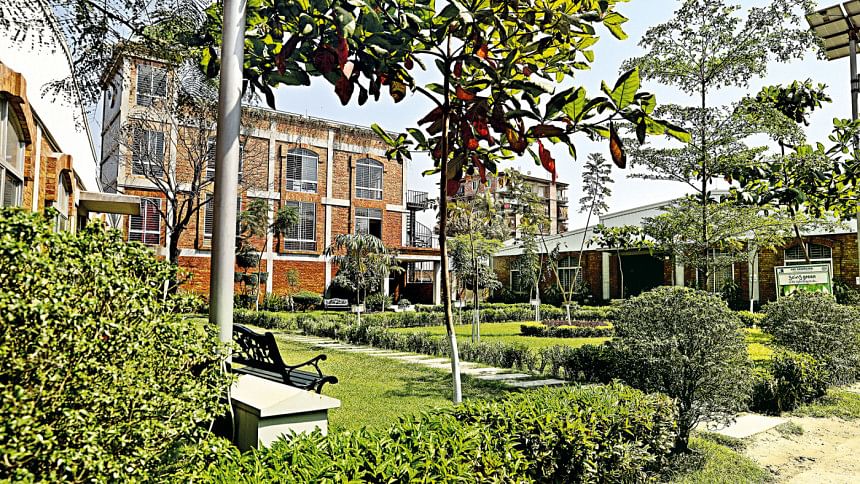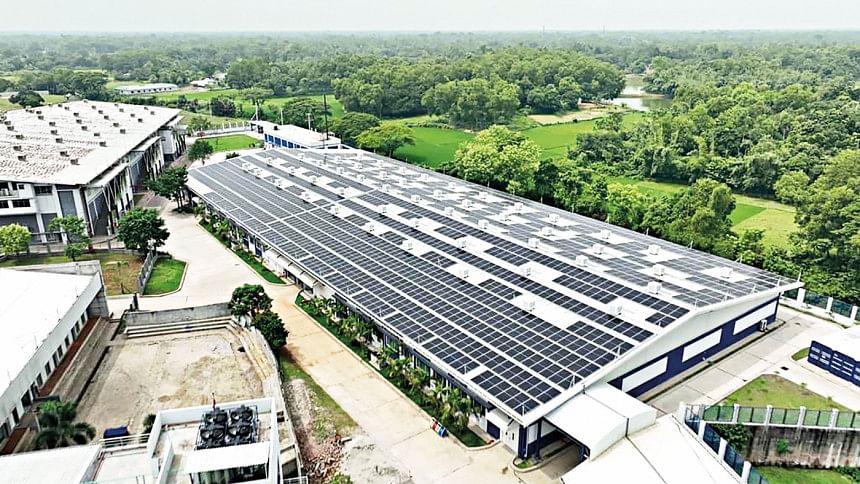Green factories: Bangladesh is a global champion

The midday sun blazes down on SM Sourcing, the world's highest-rated green garment factory in Gazipur's Konabari. About 60 workers on one of the factory floors are busy making export-quality frocks as they hurriedly finish their work ahead of lunch. Despite the summer heat outside, only a few ceiling fans are switched on and the factory floor is quite cool.
Although there is not a single air cooler, the atmosphere inside the factory – which scored 106 out of 110 points in the United States Green Building Council's (USGBC) Leadership in Energy and Environmental Design (LEED) rating system – remains comfortable.
Despite SM Sourcing being a small unit that employs just 900 workers, it has been using green technologies to make the factory floor welcoming.
The factory, established on nearly four bighas of land, has left 35 percent of the space open and planted trees to facilitate the free flow of fresh air inside and outside the factory. The ceiling is five feet higher than in normal buildings, so rooms are not easily warmed by the summer heat. It also reduces humidity.

Several exhaust fans have been installed to suck out warm air and draw in fresh air. Therefore, only a few electric fans are adequate to cool the room. The open space inside the factory harvests rainwater during the rainy days to use as an alternative to groundwater.
The factory uses 45 kilowatts of electricity produced every day from its solar panel which lessens the use of fossil fuel-generated power. The total requirement of electricity for the unit is 225 kilowatts daily.
The cost to build a platinum-rated LEED-certified unit is nearly 40 percent more than it would cost to build a normal factory. But despite the additional cost, a good number of entrepreneurs in Bangladesh have transformed their factories into green units to tailor their facilities to the global standard.
The USGBC has four categories for green building: platinum, gold, silver and green. Bangladesh, which has demonstrated exceptional dedication to eco-friendly practices, now has 213 LEED-certified factories, with 80 platinum and 119 gold-rated factories. Currently, Bangladesh is home to 54 of the top 100 LEED-certified factories globally, including nine out of the top 10, and 18 out of the top 20 units. Additionally, the country boasts the two highest-rated LEED-certified factories.
This remarkable accomplishment highlights the garment sector's vision and continued commitment to sustainability while showcasing the immense potential of Bangladesh as a leader in responsible manufacturing. The recognition of green performance opens the doors to future investments and partnerships, propelling the nation towards a sustainable future.
In the past, local manufacturers used to conduct business in conventional factory buildings, which often overlooked global best practices and polluted the environment. However, industrial incidents served as an eye-opener.
Following the nation's deadliest industrial disasters, including the fire at the Tazreen Fashions in November 2012 and the Rana Plaza building collapse in April 2013, western consumers were openly avoiding Bangladeshi garment items. Consumers even took up positions in front of stores in Europe and the US and chanted slogans against garment items made in Bangladesh, saying they were produced in 'sweatshops' and were 'blood-stained'.

As such, Bangladeshi garment manufacturers and exporters found themselves in hot water, with international retailers and brands in Europe and the US signalling that they would abandon the nation because of the image crisis. At the same time, in June 2013, the US suspended the Generalised System of Preferences (GSP) status for Bangladesh, citing poor labour rights and poor workplace safety in the garment sector.
At a time when rights groups were already criticising the country's garment sector, the decision from the Obama Administration simply rubbed salt into the wound. By this time, European and North American retailers and brands had formed the Accord on Fire and Building Safety in Bangladesh and the Alliance for Bangladesh Worker Safety to inspect, recommend and remediate loopholes in the areas of fire, structural and electrical safety in the garment sector.
The Accord and the Alliance inspected nearly all garment factories that conduct business with international buyers. They recommended the abandonment of existing factory buildings, significant remediation, or relocation, particularly away from dense areas of Dhaka.
The recommendations helped manufacturers build new factories with most of the safety measures. With the vision of winning the hearts of Western consumers, entrepreneurs also started greening their production units spending millions of dollars to become more competitive in the global apparel trade.
The green initiative helped brighten the image of the sector and Bangladesh eventually became the second-largest garment exporter after China, capturing 7.9 percent of the global garment trade.
A hospitable working environment was long overdue as many labelled Bangladeshi as sweatshops. An inhospitable work environment, including temperatures that ran very hot, also affected productivity and air coolers led to owners incurring huge electricity bills. As a result, greening factories became a clear choice, with initial costs offset by quick returns. The eco-friendly measures won the hearts of consumers.
Ananta Ahmed, a USGBC faculty and an expert in green building, says it is not possible to say how far carbon emissions have been reduced in total. But he offers a glimpse by providing individual numbers. For instance, at SM Sourcing, 2,000 tonnes of carbon emissions are prevented each year, which is equivalent to planting 67,000 trees.
Because of the improvement of the work environment, productivity increases, he says, adding that a return on investment can be seen in three years because of energy and water savings and due to higher levels of efficiency.
With such wonderful outcomes, local garment factories are opting for further greening of their production units and more than 500 units are waiting to be certified by the USGBC in the LEED category.

 For all latest news, follow The Daily Star's Google News channel.
For all latest news, follow The Daily Star's Google News channel. 




Comments